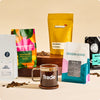“Strong” is a word you hear a lot when people talk about coffee and it has the honor, amongst words, of being used often both by both coffee pros and everyday coffee drinkers. “Extraction,” for example, is a word most baristas know well, but the average customer won’t really use. “Bold,” on the other hand, pops up quite a bit with customers, but doesn’t really mean anything specific as insider jargon.
Everyone, however, talks about whether coffee is too strong, too weak, or just the right strength. So, today we're discussing what coffee strength technically means and, more importantly, how you can use that knowledge to make your cup of coffee more to your liking.
Recently we delved into what coffee actually is, and while writing it realized that one of the reasons coffee can be so confusing is that we use the single word coffee to refer to a plant, the roasted seed of that plant, and the beverage made from that seed. Coffee (the beverage) has two ingredients: water and dissolved coffee solids (aka all those particles you get out of the coffee grounds that turn the water brown).
And when we use the word strength as jargon, we’re not referring to the roast level of the coffee solids, but rather referring to what percentage of a beverage is made up of those dissolved coffee solids. For example, in your average cup of drip coffee, around 1.25 percent of that coffee is made up of those dissolved solids, while they other 98.75 percent is water. For a shot of espresso, that number goes up to 10 percent, making espresso literally a stronger drink than drip coffee.
Strength and caffeine
As much as we focus on drinking coffee for its flavor, caffeine is just as valid a reason to drink coffee. So, stronger coffee means more caffeine, right? As with many coffee questions, the answer is a firm “kind of.”
Most double espresso recipes start with a pretty similar amount of coffee grounds as recipes for one cup of drip coffee. So while there’s more caffeine by volume in espresso, the total amount of it is basically the same. That concentration might deliver the caffeine to your system faster, but the overall amount isn’t different. If you’ve ever had a beer and a shot of liquor, the analogy writes itself. For a more counterintuitive example, we would still refer to a shot of decaf espresso as stronger than a caffeinated drip coffee, because of all those other non-caffeine compounds.
Brew ratio
The main purpose of trying to understand what exactly strength means, of course, is to help you brew coffee at whatever strength you enjoy. Since strength is basically the ratio of dissolved coffee solids to water in your finished drink, the easiest way to change it is to change the ratio of coffee grinds to water in your recipe.
We refer to this as the brew ratio, and we notate it in terms of how much more water than coffee we’re using. For example 400 ml of water to 25 grams of coffee would be a 16 to 1 brew ratio. Now, if you’re using 25 grams of coffee for 400 ml of water in a French press and you like the flavors you’re getting but need more intensity, bump that up to 30 grams of coffee. Is that 13.3 to 1 brew ratio a stronger recipe than I would usually recommend? For sure! But that's the fun of brewing coffee at home for yourself.
Now it is an oversimplification to say that just changing the brew ratio will change your strength and nothing else. In brew methods where water has to flow vertically through coffee grounds (like pour overs or, especially, espresso), changing the dose can affect how long that water takes to flow through. And big changes to brew ratio might make it harder for the water to extract those flavor compounds from the grounds (think of it as the water getting too full). Still, especially in small steps, if you want to make your coffee weaker or stronger, changing that brew ratio is the easiest way to go.
Extraction percentage
It isn’t the only way to go, though. Instead of changing the amount of coffee you’re using, you could just try to pull more or less of those flavor compounds. Around 30 percent of coffee is soluble in water (that’s why, unless you’re brewing instant coffee, you’ll always have some grinds left over). How much of it we successfully dissolve and extract (those words in effect amount to the same thing) is determined by variables like grind size, brew time, and water temperature.
Coffee is super-complex and different flavors come out of it at different times during the brew process. If you extract a low percentage of compounds from that coffee, you’ll get coffee that’s sour and not sweet enough. If you extract too high a percentage, you’ll get coffee that’s too bitter.
We generally aim for around 18 to 22 percent extraction which, for almost all coffees, gives you a good balance of sweetness, acidity, and bitterness. So, while we want to be efficient with our coffee and not waste the delicious material in it, we have to leave some of those compounds in the coffee grounds if we don’t want bitter coffee.
Dilution and bypass brewing
When we write about brewing adjustments, we're usually referring to things you can do with your next brew, but if you've brewed some coffee and want to make it different without brewing another, you're not completely out of luck.
If the coffee has the right flavor balance but is too strong, you can dilute it by adding water after the fact. This won't change the extraction, just the strength. Many larger coffee brewers at coffee shops are actually doing this already in a process called "bypass," running some water around the side of the basket of grinds. This is also a more subtle version of what's happening if you're making flash-chilled iced coffee (adding water after it has run through the grounds in the form of ice) or an Americano (brewing an espresso, and then watering it down until it's at regular coffee strength).
If you've brewed coffee and need to make it stronger, you're kind of out of luck as far as quick fixes go. You can't take water out of your coffee without also taking out coffee solubles. You'll have to make adjustments on your next brew.
So if you want your coffee to be stronger or weaker the next time you brew it, there are two main roads to go down:
- If you’re happy with the balance of flavors in your coffee (it’s not too bitter or too sour, straight up Goldilocks coffee), but just want it to be more or less intense, adjust the amount of grounds.
- If you want the coffee to be more or less intense and also want the balance of sour, sweet, and bitter to be different, adjust the grind size, brew time, or temperature.
Option one is certainly a lot simpler, which I always appreciate when brewing coffee. And now that we have that straight, we’ll get into simplifying some of the more complex aspects of option two as we continue our Summer School lessons.
Enhance Your At-Home Coffee Experience with Trade
As you've discovered the joy of crafting your own iced coffee at home, why not elevate your coffee experience even further with Trade? Our mission at Trade is to bring exceptional coffee directly to your doorstep, ensuring you have access to the finest beans from the best roasters across the country.






